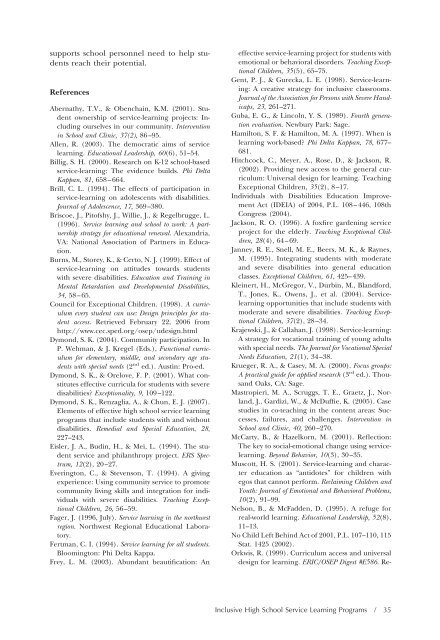Download the Journal (PDF) - Division on Autism and ...
Download the Journal (PDF) - Division on Autism and ...
Download the Journal (PDF) - Division on Autism and ...
Create successful ePaper yourself
Turn your PDF publications into a flip-book with our unique Google optimized e-Paper software.
supports school pers<strong>on</strong>nel need to help students<br />
reach <str<strong>on</strong>g>the</str<strong>on</strong>g>ir potential.<br />
References<br />
Abernathy, T.V., & Obenchain, K.M. (2001). Student<br />
ownership of service-learning projects: Including<br />
ourselves in our community. Interventi<strong>on</strong><br />
in School <strong>and</strong> Clinic, 37(2), 86–95.<br />
Allen, R. (2003). The democratic aims of service<br />
learning. Educati<strong>on</strong>al Leadership, 60(6), 51–54.<br />
Billig, S. H. (2000). Research <strong>on</strong> K-12 school-based<br />
service-learning: The evidence builds. Phi Delta<br />
Kappan, 81, 658–664.<br />
Brill, C. L. (1994). The effects of participati<strong>on</strong> in<br />
service-learning <strong>on</strong> adolescents with disabilities.<br />
<str<strong>on</strong>g>Journal</str<strong>on</strong>g> of Adolescence, 17, 369–380.<br />
Briscoe, J., Pitofshy, J., Willie, J., & Regelbrugge, L.<br />
(1996). Service learning <strong>and</strong> school to work: A partnership<br />
strategy for educati<strong>on</strong>al renewal. Alex<strong>and</strong>ria,<br />
VA: Nati<strong>on</strong>al Associati<strong>on</strong> of Partners in Educati<strong>on</strong>.<br />
Burns, M., Storey, K., & Certo, N. J. (1999). Effect of<br />
service-learning <strong>on</strong> attitudes towards students<br />
with severe disabilities. Educati<strong>on</strong> <strong>and</strong> Training in<br />
Mental Retardati<strong>on</strong> <strong>and</strong> Developmental Disabilities,<br />
34, 58–65.<br />
Council for Excepti<strong>on</strong>al Children. (1998). A curriculum<br />
every student can use: Design principles for student<br />
access. Retrieved February 22, 2006 from<br />
http://www.cec.sped.org/osep/udesign.html<br />
Dym<strong>on</strong>d, S. K. (2004). Community participati<strong>on</strong>. In<br />
P. Wehman, & J. Kregel (Eds.), Functi<strong>on</strong>al curriculum<br />
for elementary, middle, <strong>and</strong> sec<strong>on</strong>dary age students<br />
with special needs (2 nd ed.). Austin: Pro-ed.<br />
Dym<strong>on</strong>d, S. K., & Orelove, F. P. (2001). What c<strong>on</strong>stitutes<br />
effective curricula for students with severe<br />
disabilities? Excepti<strong>on</strong>ality, 9, 109–122.<br />
Dym<strong>on</strong>d, S. K., Renzaglia, A., & Chun, E. J. (2007).<br />
Elements of effective high school service learning<br />
programs that include students with <strong>and</strong> without<br />
disabilities. Remedial <strong>and</strong> Special Educati<strong>on</strong>, 28,<br />
227–243.<br />
Eisler, J. A., Budin, H., & Mei, L. (1994). The student<br />
service <strong>and</strong> philanthropy project. ERS Spectrum,<br />
12(2), 20–27.<br />
Everingt<strong>on</strong>, C., & Stevens<strong>on</strong>, T. (1994). A giving<br />
experience: Using community service to promote<br />
community living skills <strong>and</strong> integrati<strong>on</strong> for individuals<br />
with severe disabilities. Teaching Excepti<strong>on</strong>al<br />
Children, 26, 56–59.<br />
Fager, J. (1996, July). Service learning in <str<strong>on</strong>g>the</str<strong>on</strong>g> northwest<br />
regi<strong>on</strong>. Northwest Regi<strong>on</strong>al Educati<strong>on</strong>al Laboratory.<br />
Fertman, C. I. (1994). Service learning for all students.<br />
Bloomingt<strong>on</strong>: Phi Delta Kappa.<br />
Frey, L. M. (2003). Abundant beautificati<strong>on</strong>: An<br />
effective service-learning project for students with<br />
emoti<strong>on</strong>al or behavioral disorders. Teaching Excepti<strong>on</strong>al<br />
Children, 35(5), 65–75.<br />
Gent, P. J., & Gurecka, L. E. (1998). Service-learning:<br />
A creative strategy for inclusive classrooms.<br />
<str<strong>on</strong>g>Journal</str<strong>on</strong>g> of <str<strong>on</strong>g>the</str<strong>on</strong>g> Associati<strong>on</strong> for Pers<strong>on</strong>s with Severe H<strong>and</strong>icaps,<br />
23, 261–271.<br />
Guba, E. G., & Lincoln, Y. S. (1989). Fourth generati<strong>on</strong><br />
evaluati<strong>on</strong>. Newbury Park: Sage.<br />
Hamilt<strong>on</strong>, S. F. & Hamilt<strong>on</strong>, M. A. (1997). When is<br />
learning work-based? Phi Delta Kappan, 78, 677–<br />
681.<br />
Hitchcock, C., Meyer, A., Rose, D., & Jacks<strong>on</strong>, R.<br />
(2002). Providing new access to <str<strong>on</strong>g>the</str<strong>on</strong>g> general curriculum:<br />
Universal design for learning. Teaching<br />
Excepti<strong>on</strong>al Children, 35(2), 8–17.<br />
Individuals with Disabilities Educati<strong>on</strong> Improvement<br />
Act (IDEIA) of 2004, P.L. 108–446, 108th<br />
C<strong>on</strong>gress (2004).<br />
Jacks<strong>on</strong>, R. O. (1996). A foxfire gardening service<br />
project for <str<strong>on</strong>g>the</str<strong>on</strong>g> elderly. Teaching Excepti<strong>on</strong>al Children,<br />
28(4), 64–69.<br />
Janney, R. E., Snell, M. E., Beers, M. K., & Raynes,<br />
M. (1995). Integrating students with moderate<br />
<strong>and</strong> severe disabilities into general educati<strong>on</strong><br />
classes. Excepti<strong>on</strong>al Children, 61, 425–439.<br />
Kleinert, H., McGregor, V., Durbin, M., Bl<strong>and</strong>ford,<br />
T., J<strong>on</strong>es, K., Owens, J., et al. (2004). Servicelearning<br />
opportunities that include students with<br />
moderate <strong>and</strong> severe disabilities. Teaching Excepti<strong>on</strong>al<br />
Children, 37(2), 28–34.<br />
Krajewski, J., & Callahan, J. (1998). Service-learning:<br />
A strategy for vocati<strong>on</strong>al training of young adults<br />
with special needs. The <str<strong>on</strong>g>Journal</str<strong>on</strong>g> for Vocati<strong>on</strong>al Special<br />
Needs Educati<strong>on</strong>, 21(1), 34–38.<br />
Krueger, R. A., & Casey, M. A. (2000). Focus groups:<br />
A practical guide for applied research (3 rd ed.). Thous<strong>and</strong><br />
Oaks, CA: Sage.<br />
Mastropieri, M. A., Scruggs, T. E., Graetz, J., Norl<strong>and</strong>,<br />
J., Gardizi, W., & McDuffie, K. (2005). Case<br />
studies in co-teaching in <str<strong>on</strong>g>the</str<strong>on</strong>g> c<strong>on</strong>tent areas: Successes,<br />
failures, <strong>and</strong> challenges. Interventi<strong>on</strong> in<br />
School <strong>and</strong> Clinic, 40, 260–270.<br />
McCarty, B., & Hazelkorn, M. (2001). Reflecti<strong>on</strong>:<br />
The key to social-emoti<strong>on</strong>al change using servicelearning.<br />
Bey<strong>on</strong>d Behavior, 10(3), 30–35.<br />
Muscott, H. S. (2001). Service-learning <strong>and</strong> character<br />
educati<strong>on</strong> as “antidotes” for children with<br />
egos that cannot perform. Reclaiming Children <strong>and</strong><br />
Youth: <str<strong>on</strong>g>Journal</str<strong>on</strong>g> of Emoti<strong>on</strong>al <strong>and</strong> Behavioral Problems,<br />
10(2), 91–99.<br />
Nels<strong>on</strong>, B., & McFadden, D. (1995). A refuge for<br />
real-world learning. Educati<strong>on</strong>al Leadership, 52(8),<br />
11–13.<br />
No Child Left Behind Act of 2001, P.L. 107–110, 115<br />
Stat. 1425 (2002).<br />
Orkwis, R. (1999). Curriculum access <strong>and</strong> universal<br />
design for learning. ERIC/OSEP Digest #E586. Re-<br />
Inclusive High School Service Learning Programs / 35
















